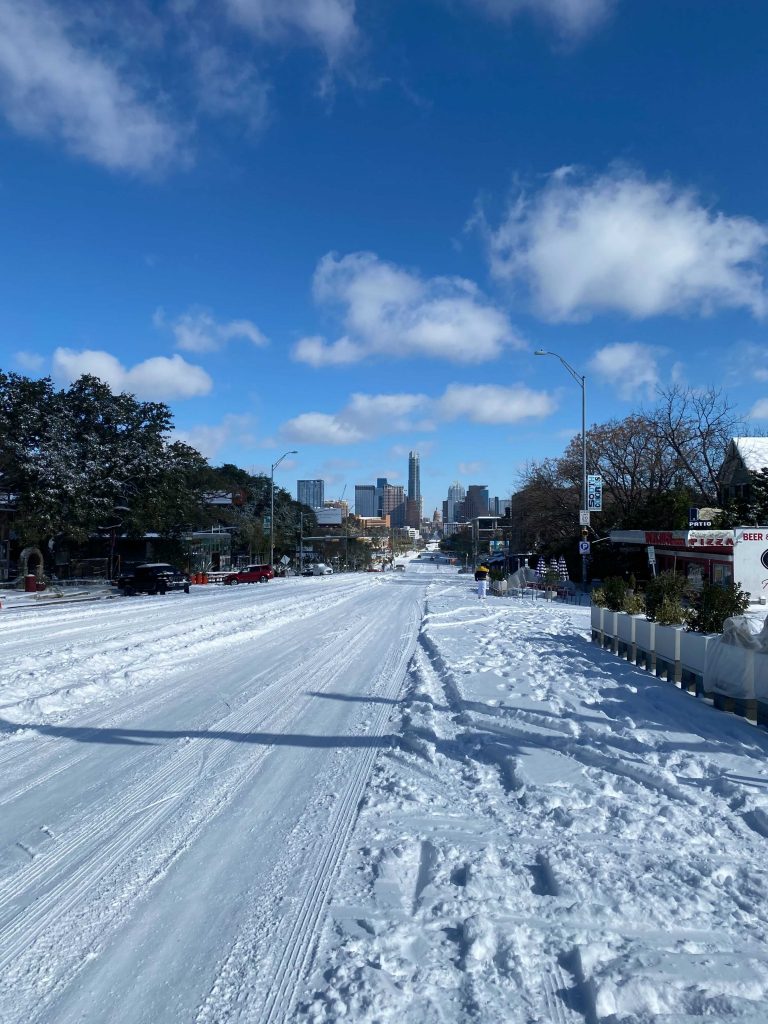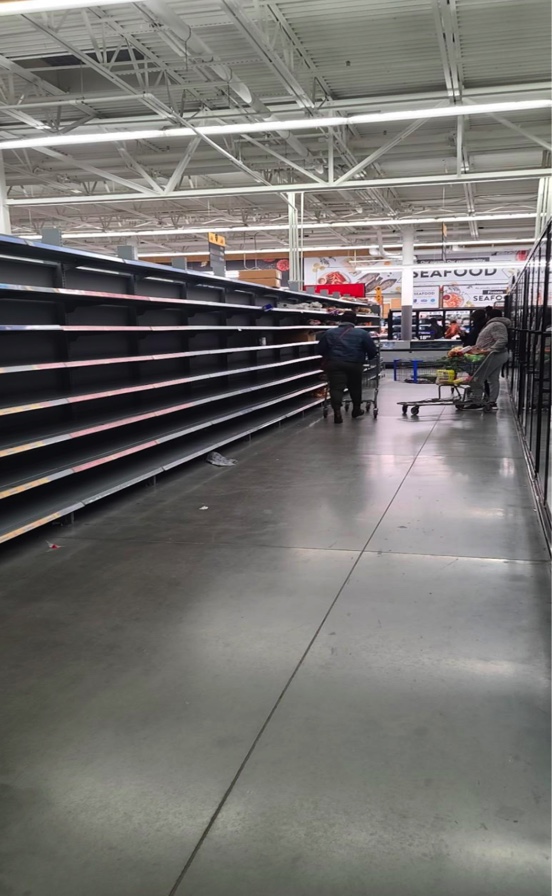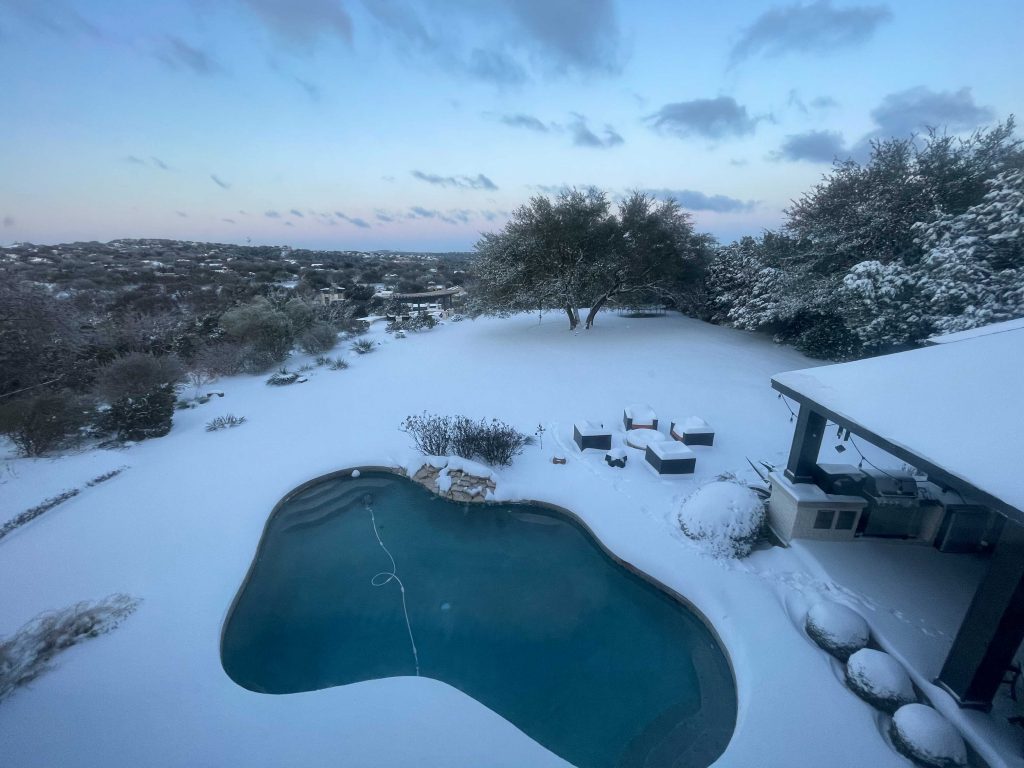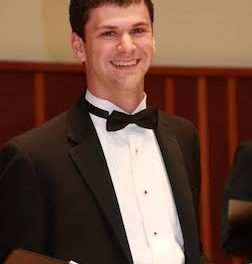Amid a pandemic on the most romantic day of the year, the perfect storm hit Texas.
Texas faced record-low temperatures as Winter Storm Uri swept across the state on Feb. 14. Unprepared for extreme weather conditions, the Energy Reliability Council of Texas (ERCOT) – the state’s power grid operator – failed to meet the increasing energy demands, leaving millions of Texans without access to electricity or heat.
After enduring multiple days of subfreezing temperatures, over 14.4 million Texans in 190 counties continue to face water disruptions without a clear end in sight.
Kendall Kalmans (24C), who is attending classes from her home in Houston, described the initial, collective sense of curious bewilderment as Texans basked in the foreign flurries, unaware of the turmoil to come.
“It was like the snow day that everyone dreams of until Monday when people started losing power,” Kalmans said.

South Congress, a major road in Austin, TX, was completely covered in snow on Feb. 15. (Colter Frey)
Mo Singhal (22C), a student currently residing in Dallas, echoed feeling astonished when snow first arrived on his doorstep.
“I’ve been here for about 12, 13 years now, and I’ve never seen it get below 20 degrees even,” Singhal said. “But the Saturday, Sunday right there on the six degrees Fahrenheit, that was pretty freezing, pretty cold, especially when, like, you don’t see snow very often in Dallas.”
The winter dreamscape lost its allure early Monday morning as mass power outages raged statewide. With plummeting temperatures, Texas’ energy infrastructure proved ill-equipped for the extreme weather conditions, cutting energy production to a mere half of ERCOT’s winter generating capacity.
Despite expert recommendations to “winterize” energy infrastructure following similar power outages in a 2011 winter storm, Texas power companies opted out of necessary upgrades to save money, leaving residents in the dark.
Living up to its nickname, the Lone Star State established an isolated power grid in 1970 to circumvent government regulation. Without assistance from the national energy grids, Texas failed to meet the peak demand for power and heat.
Without electricity and reliable communication, freezing Texans faced uncertainty and feared abandonment.
For Cutler Cannon (20Ox, 22C), who is currently living in Atlanta, this fear was exacerbated by an inability to contact his loved ones in Van Alstyne, Texas, located 30 minutes outside of the Texas-Oklahoma border.
“Electricity didn’t necessarily affect my household, but it affected the cell towers so there were extended times that I didn’t hear from my parents,” Cannon said. “I didn’t have any way to reach them.”
In Houston, Kalmans faced other concerns. She described an alarming scene at a grocery store where residents scrambled to prepare for food and water shortages.
“There were probably 150 people in the parking lot waiting when it opened at 10 a.m.,” she recalled. “In terms of food, it was like grab what you can, like there was no eggs, no milk, no nothing.”

Barren shelves abound in a Van Alstyne, TX Walmart. (Cutler Cannon)
Enduring mass power outages and food shortages, the worst was yet to come.
“An even bigger issue was the water because there were a lot of pipes that burst,” Kalmans explained. “They haven’t been able to fix all the pipes, so bacteria gets in where the pipes are burst … making it unsafe to be consumed directly from the faucets.”
This widespread infrastructure failure has left 14.4 million Texans governed by water boil notices, including more than 150,000 without clean water. Cannon described a story experienced by many Texans:
“A pipe burst … and over 500 gallons of water flooded our basement. That was really unfortunate because we had recently had a break just a few months ago … And we had to put all this money forth for insurance claims.”
Facing skyrocketing insurance premiums for extensive property damages, Cannon said Uri’s economic implications will reverberate throughout his community long after the storm passes. Singhal explained that poor infrastructure allowed the storm to cause severe home damage, including collapsing roofs.
Freezing and with scant governmental assistance, communities across Texas united to help struggling neighbors. Cannon described the immediate reaction among the Van Alstyne community, where Texans came together to offer housing, food or transportation to one another.
Although her neighborhood lost power on Feb. 15, Kalmans’ family had invested in a generator after Hurricane Harvey and so they opened their home to her neighbors. While the shared trauma forced people to come together, Kalmans noted the fear of COVID-19 still loomed.
“It’s hard because I want to help as many people as I can,” Kalmans said. “Our house has been relatively empty since COVID, and now it almost feels in some ways like a revolving door … With the virus, I wouldn’t be surprised if cases start to rise again in Texas because people are desperate.”

A Texan’s pool is frozen-over and backyard is blanketed by snow. (Tori Fredell)
Despite withstanding physically and mentally exhausting conditions, students faced an additional layer of stress virtually. Without Wi-Fi, Texas students could not attend Zoom calls or stream lectures and were cut off from college life.
“All my professors were really, really understanding,” Singhal said. “I had a couple of them emailing me every day, like, hey, how are you doing? Is there anything else I can do for you? One professor was like, you have an exam. And I was like, I have a storm.”
Although acknowledging her professors’ sympathetic responses, Kalmans criticized administrators’ delayed response which came on Thursday afternoon, days after the power outages began.
“It was almost inappropriate how long it took the University to reach out,” Kalmans said. “And I still haven’t seen any communication that’s gone out to the public of the University as a whole. I only received an email because I am from Texas and currently in Texas.”
University President Gregory L. Fenves tweeted on Feb. 19, offering support for Emory students affected by the storm.
“My heart goes out to all of the residents of Texas including my family, friends and everyone at @UTAustin. Please be safe during this incredible confluence of covid and extreme weather. I’m proud of Texans,” Fenves tweeted five days after Uri arrived in Texas.
As the lights in Texas turn back on, students grapple with questions about what the state’s future will hold.
“Honestly, like now it’s just kind of stress of what’s going to be done to prevent this in the future,” Cannon said. “It will either make it so much worse for me because nothing’s happening or if it will make it a little bit better if we see appropriate actions being taken.”
A week after Uri’s arrival, Kalmans remarked that Houston was 65 degrees and sunny, “throwing out Powerball numbers for weather.” However, the widespread damage across Texas will not melt away as easily as the snow.
“We’re trying to pick up the pieces now,” Kalmans said. “I think people are tired of picking up the pieces, but what I learned about my community is that we’ll continue to move forward.”




Nice